Nursing Leadership
VerifiedAdded on 2023/04/21
|9
|2880
|94
AI Summary
This essay provides a critical analysis of nursing leadership, focusing on transformational leadership theory and its implications for leadership practice. It discusses a clinical practice scenario and reflects on the events and the author's leadership style.
Contribute Materials
Your contribution can guide someone’s learning journey. Share your
documents today.
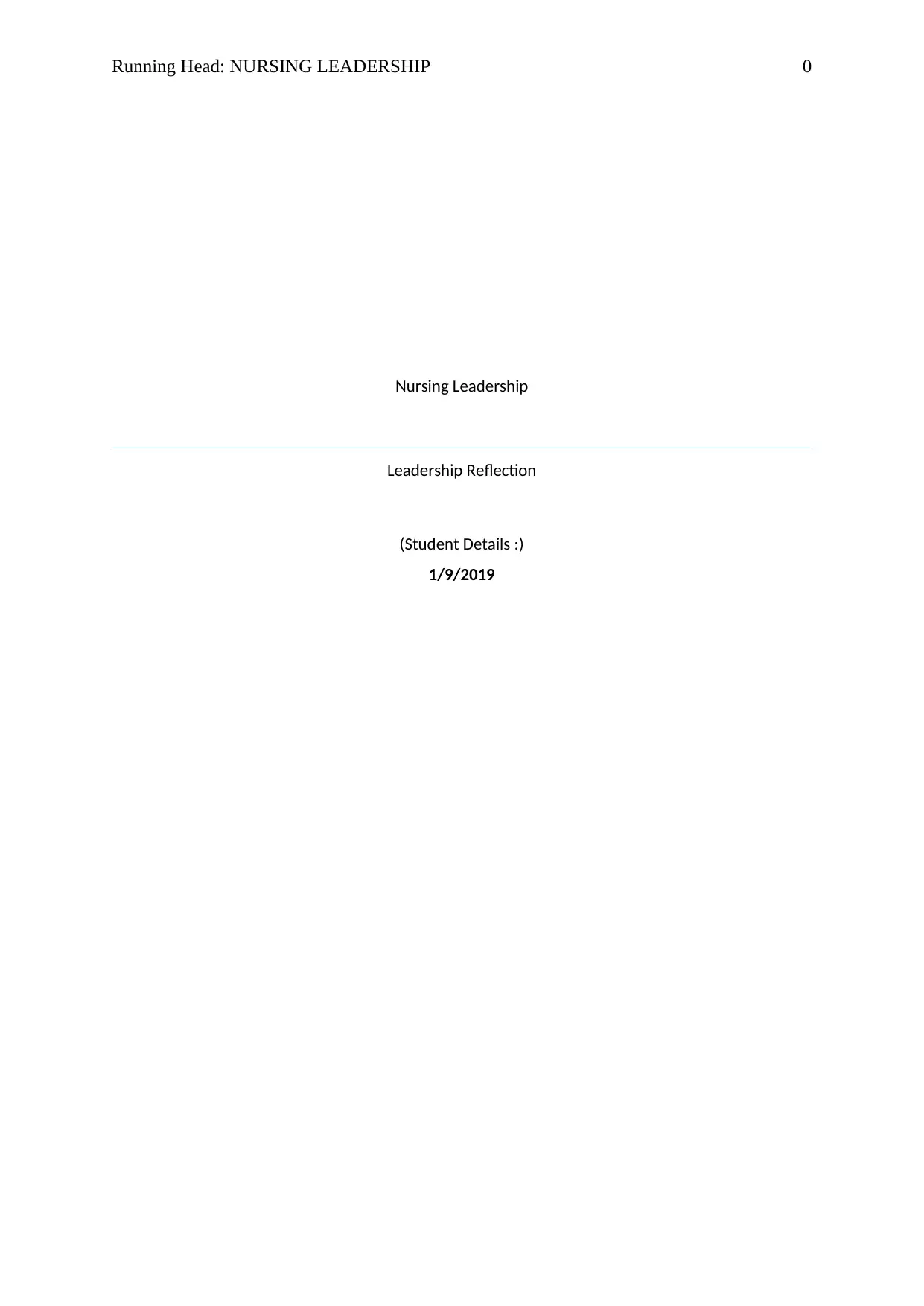
Running Head: NURSING LEADERSHIP 0
Nursing Leadership
Leadership Reflection
(Student Details :)
1/9/2019
Nursing Leadership
Leadership Reflection
(Student Details :)
1/9/2019
Secure Best Marks with AI Grader
Need help grading? Try our AI Grader for instant feedback on your assignments.
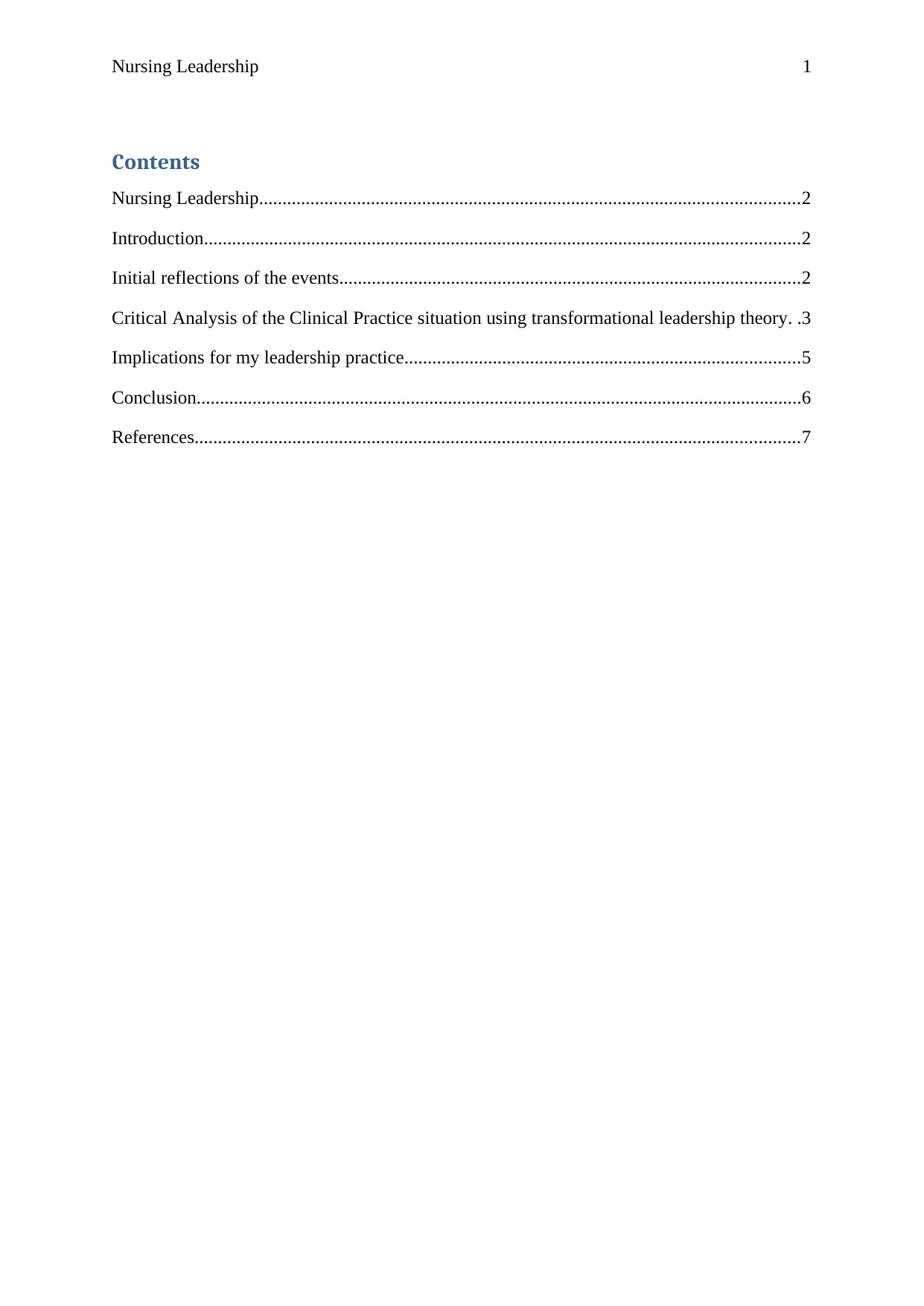
Nursing Leadership 1
Contents
Nursing Leadership....................................................................................................................2
Introduction................................................................................................................................2
Initial reflections of the events...................................................................................................2
Critical Analysis of the Clinical Practice situation using transformational leadership theory. .3
Implications for my leadership practice.....................................................................................5
Conclusion..................................................................................................................................6
References..................................................................................................................................7
Contents
Nursing Leadership....................................................................................................................2
Introduction................................................................................................................................2
Initial reflections of the events...................................................................................................2
Critical Analysis of the Clinical Practice situation using transformational leadership theory. .3
Implications for my leadership practice.....................................................................................5
Conclusion..................................................................................................................................6
References..................................................................................................................................7
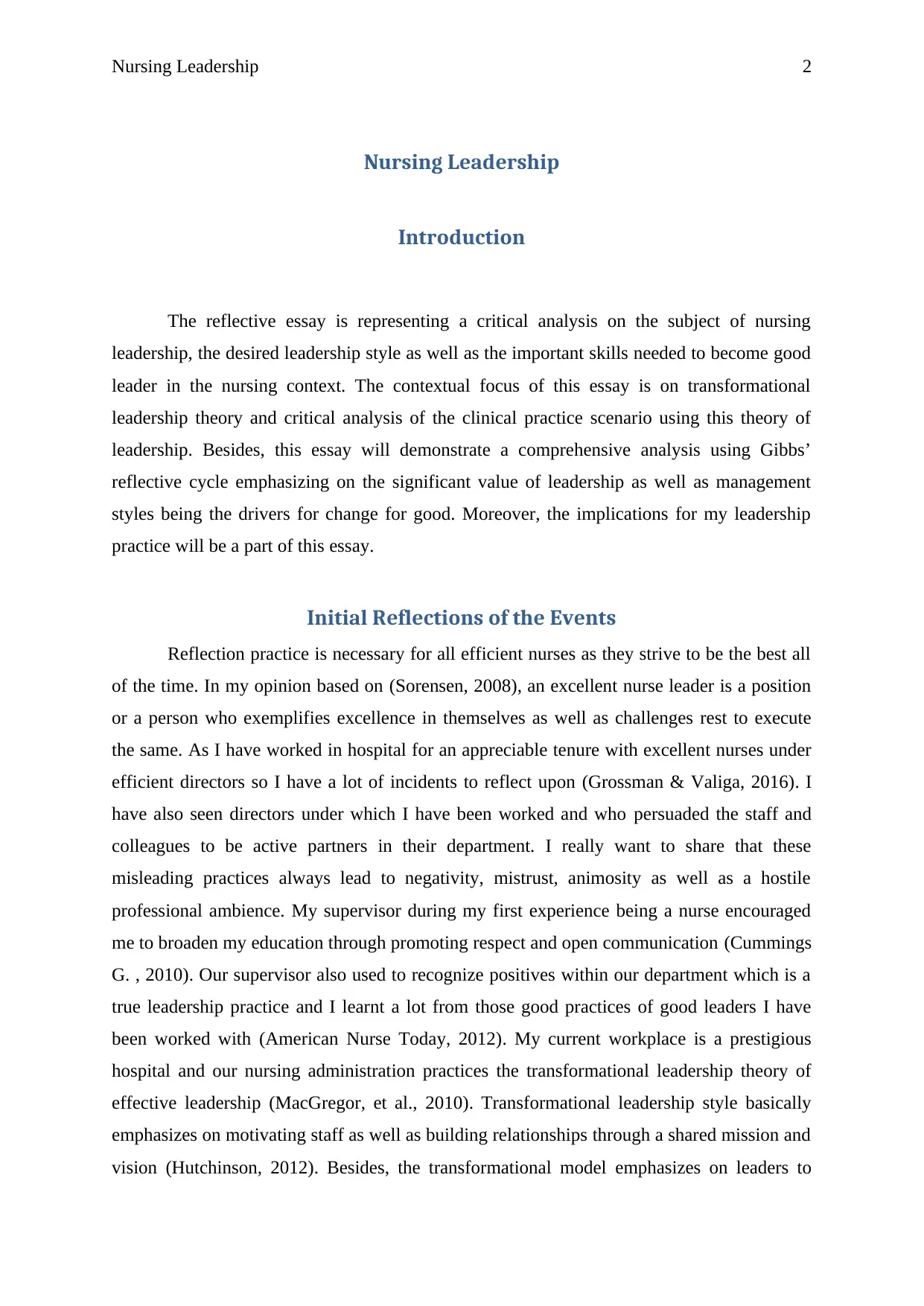
Nursing Leadership 2
Nursing Leadership
Introduction
The reflective essay is representing a critical analysis on the subject of nursing
leadership, the desired leadership style as well as the important skills needed to become good
leader in the nursing context. The contextual focus of this essay is on transformational
leadership theory and critical analysis of the clinical practice scenario using this theory of
leadership. Besides, this essay will demonstrate a comprehensive analysis using Gibbs’
reflective cycle emphasizing on the significant value of leadership as well as management
styles being the drivers for change for good. Moreover, the implications for my leadership
practice will be a part of this essay.
Initial Reflections of the Events
Reflection practice is necessary for all efficient nurses as they strive to be the best all
of the time. In my opinion based on (Sorensen, 2008), an excellent nurse leader is a position
or a person who exemplifies excellence in themselves as well as challenges rest to execute
the same. As I have worked in hospital for an appreciable tenure with excellent nurses under
efficient directors so I have a lot of incidents to reflect upon (Grossman & Valiga, 2016). I
have also seen directors under which I have been worked and who persuaded the staff and
colleagues to be active partners in their department. I really want to share that these
misleading practices always lead to negativity, mistrust, animosity as well as a hostile
professional ambience. My supervisor during my first experience being a nurse encouraged
me to broaden my education through promoting respect and open communication (Cummings
G. , 2010). Our supervisor also used to recognize positives within our department which is a
true leadership practice and I learnt a lot from those good practices of good leaders I have
been worked with (American Nurse Today, 2012). My current workplace is a prestigious
hospital and our nursing administration practices the transformational leadership theory of
effective leadership (MacGregor, et al., 2010). Transformational leadership style basically
emphasizes on motivating staff as well as building relationships through a shared mission and
vision (Hutchinson, 2012). Besides, the transformational model emphasizes on leaders to
Nursing Leadership
Introduction
The reflective essay is representing a critical analysis on the subject of nursing
leadership, the desired leadership style as well as the important skills needed to become good
leader in the nursing context. The contextual focus of this essay is on transformational
leadership theory and critical analysis of the clinical practice scenario using this theory of
leadership. Besides, this essay will demonstrate a comprehensive analysis using Gibbs’
reflective cycle emphasizing on the significant value of leadership as well as management
styles being the drivers for change for good. Moreover, the implications for my leadership
practice will be a part of this essay.
Initial Reflections of the Events
Reflection practice is necessary for all efficient nurses as they strive to be the best all
of the time. In my opinion based on (Sorensen, 2008), an excellent nurse leader is a position
or a person who exemplifies excellence in themselves as well as challenges rest to execute
the same. As I have worked in hospital for an appreciable tenure with excellent nurses under
efficient directors so I have a lot of incidents to reflect upon (Grossman & Valiga, 2016). I
have also seen directors under which I have been worked and who persuaded the staff and
colleagues to be active partners in their department. I really want to share that these
misleading practices always lead to negativity, mistrust, animosity as well as a hostile
professional ambience. My supervisor during my first experience being a nurse encouraged
me to broaden my education through promoting respect and open communication (Cummings
G. , 2010). Our supervisor also used to recognize positives within our department which is a
true leadership practice and I learnt a lot from those good practices of good leaders I have
been worked with (American Nurse Today, 2012). My current workplace is a prestigious
hospital and our nursing administration practices the transformational leadership theory of
effective leadership (MacGregor, et al., 2010). Transformational leadership style basically
emphasizes on motivating staff as well as building relationships through a shared mission and
vision (Hutchinson, 2012). Besides, the transformational model emphasizes on leaders to
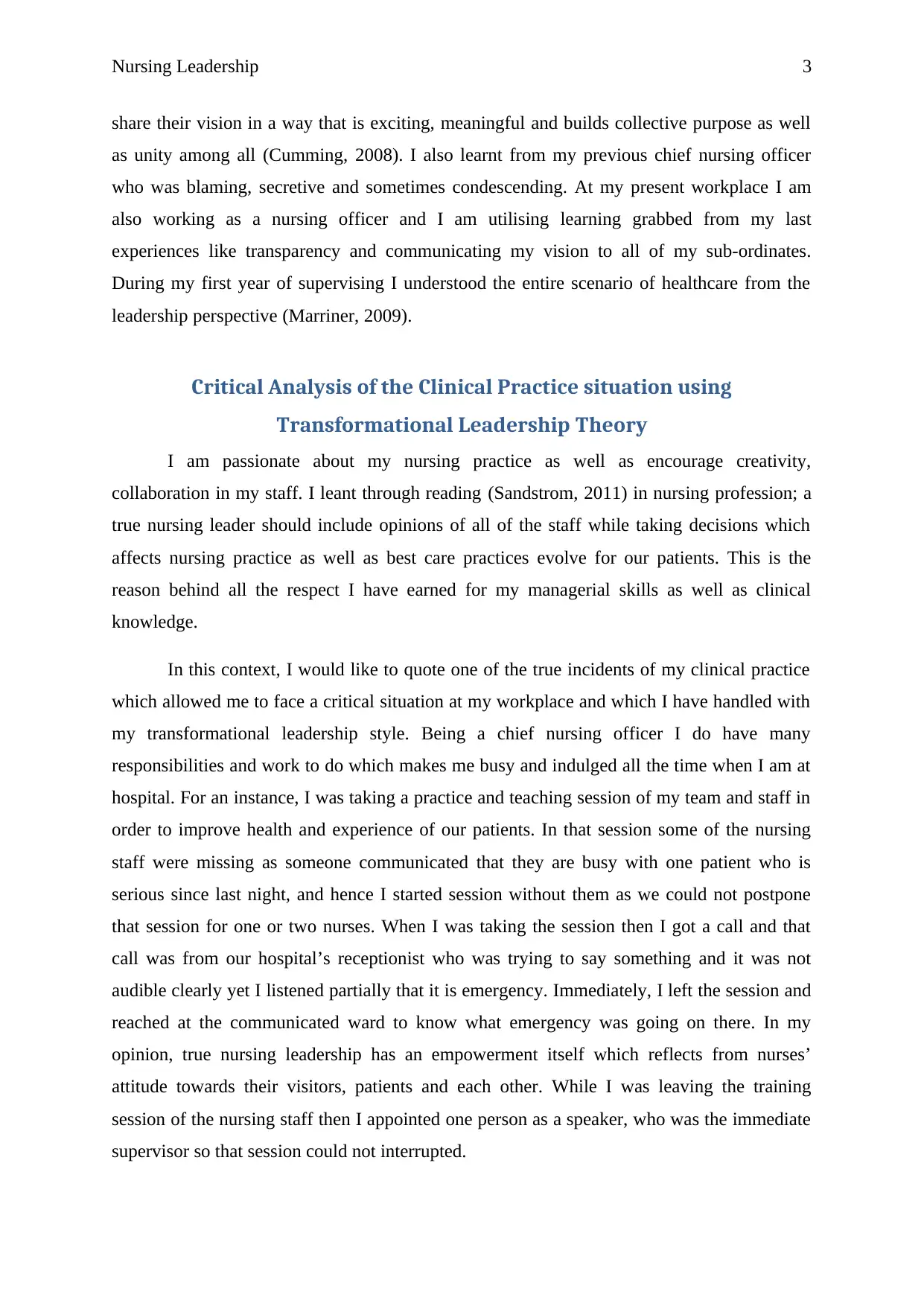
Nursing Leadership 3
share their vision in a way that is exciting, meaningful and builds collective purpose as well
as unity among all (Cumming, 2008). I also learnt from my previous chief nursing officer
who was blaming, secretive and sometimes condescending. At my present workplace I am
also working as a nursing officer and I am utilising learning grabbed from my last
experiences like transparency and communicating my vision to all of my sub-ordinates.
During my first year of supervising I understood the entire scenario of healthcare from the
leadership perspective (Marriner, 2009).
Critical Analysis of the Clinical Practice situation using
Transformational Leadership Theory
I am passionate about my nursing practice as well as encourage creativity,
collaboration in my staff. I leant through reading (Sandstrom, 2011) in nursing profession; a
true nursing leader should include opinions of all of the staff while taking decisions which
affects nursing practice as well as best care practices evolve for our patients. This is the
reason behind all the respect I have earned for my managerial skills as well as clinical
knowledge.
In this context, I would like to quote one of the true incidents of my clinical practice
which allowed me to face a critical situation at my workplace and which I have handled with
my transformational leadership style. Being a chief nursing officer I do have many
responsibilities and work to do which makes me busy and indulged all the time when I am at
hospital. For an instance, I was taking a practice and teaching session of my team and staff in
order to improve health and experience of our patients. In that session some of the nursing
staff were missing as someone communicated that they are busy with one patient who is
serious since last night, and hence I started session without them as we could not postpone
that session for one or two nurses. When I was taking the session then I got a call and that
call was from our hospital’s receptionist who was trying to say something and it was not
audible clearly yet I listened partially that it is emergency. Immediately, I left the session and
reached at the communicated ward to know what emergency was going on there. In my
opinion, true nursing leadership has an empowerment itself which reflects from nurses’
attitude towards their visitors, patients and each other. While I was leaving the training
session of the nursing staff then I appointed one person as a speaker, who was the immediate
supervisor so that session could not interrupted.
share their vision in a way that is exciting, meaningful and builds collective purpose as well
as unity among all (Cumming, 2008). I also learnt from my previous chief nursing officer
who was blaming, secretive and sometimes condescending. At my present workplace I am
also working as a nursing officer and I am utilising learning grabbed from my last
experiences like transparency and communicating my vision to all of my sub-ordinates.
During my first year of supervising I understood the entire scenario of healthcare from the
leadership perspective (Marriner, 2009).
Critical Analysis of the Clinical Practice situation using
Transformational Leadership Theory
I am passionate about my nursing practice as well as encourage creativity,
collaboration in my staff. I leant through reading (Sandstrom, 2011) in nursing profession; a
true nursing leader should include opinions of all of the staff while taking decisions which
affects nursing practice as well as best care practices evolve for our patients. This is the
reason behind all the respect I have earned for my managerial skills as well as clinical
knowledge.
In this context, I would like to quote one of the true incidents of my clinical practice
which allowed me to face a critical situation at my workplace and which I have handled with
my transformational leadership style. Being a chief nursing officer I do have many
responsibilities and work to do which makes me busy and indulged all the time when I am at
hospital. For an instance, I was taking a practice and teaching session of my team and staff in
order to improve health and experience of our patients. In that session some of the nursing
staff were missing as someone communicated that they are busy with one patient who is
serious since last night, and hence I started session without them as we could not postpone
that session for one or two nurses. When I was taking the session then I got a call and that
call was from our hospital’s receptionist who was trying to say something and it was not
audible clearly yet I listened partially that it is emergency. Immediately, I left the session and
reached at the communicated ward to know what emergency was going on there. In my
opinion, true nursing leadership has an empowerment itself which reflects from nurses’
attitude towards their visitors, patients and each other. While I was leaving the training
session of the nursing staff then I appointed one person as a speaker, who was the immediate
supervisor so that session could not interrupted.
Secure Best Marks with AI Grader
Need help grading? Try our AI Grader for instant feedback on your assignments.
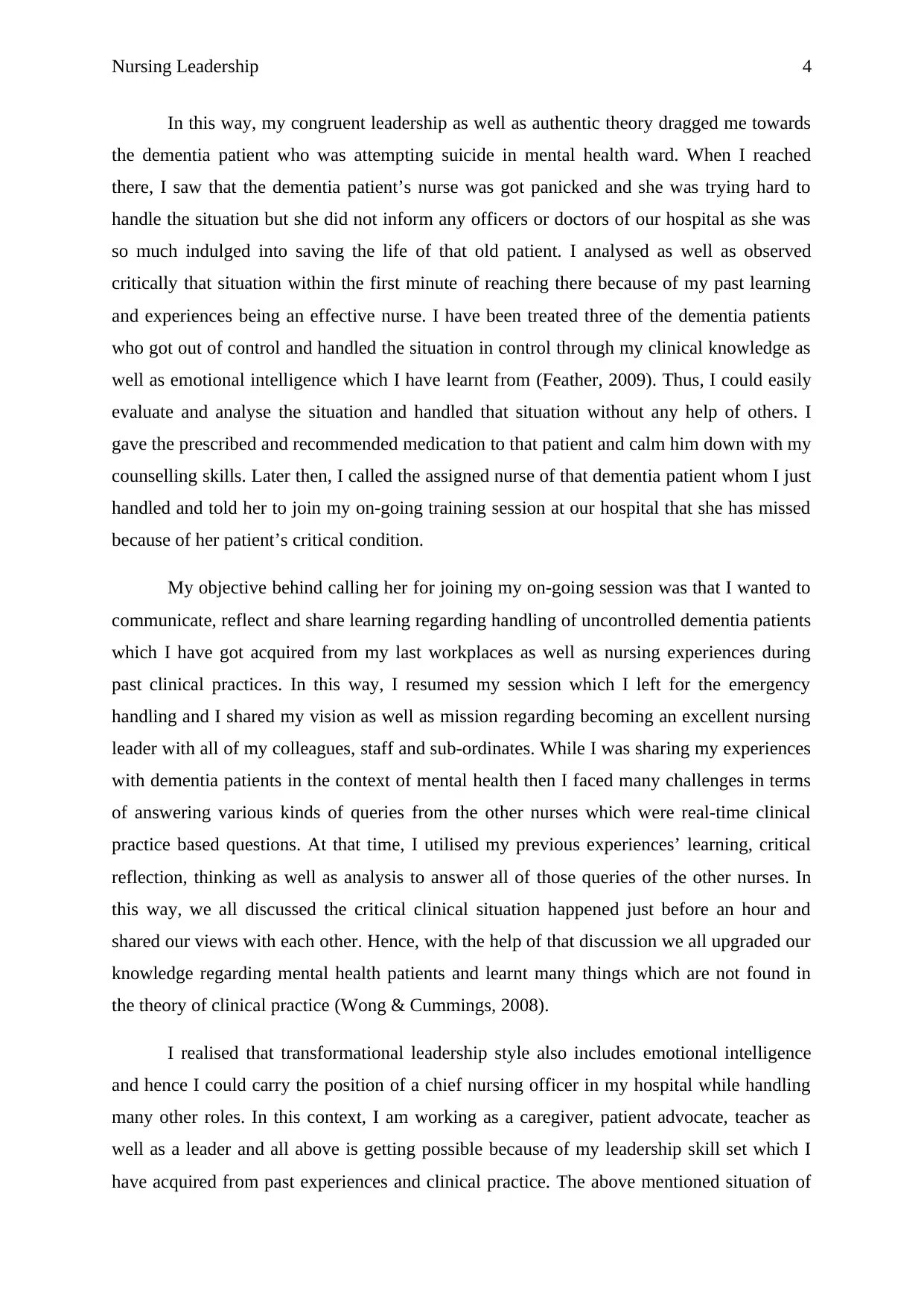
Nursing Leadership 4
In this way, my congruent leadership as well as authentic theory dragged me towards
the dementia patient who was attempting suicide in mental health ward. When I reached
there, I saw that the dementia patient’s nurse was got panicked and she was trying hard to
handle the situation but she did not inform any officers or doctors of our hospital as she was
so much indulged into saving the life of that old patient. I analysed as well as observed
critically that situation within the first minute of reaching there because of my past learning
and experiences being an effective nurse. I have been treated three of the dementia patients
who got out of control and handled the situation in control through my clinical knowledge as
well as emotional intelligence which I have learnt from (Feather, 2009). Thus, I could easily
evaluate and analyse the situation and handled that situation without any help of others. I
gave the prescribed and recommended medication to that patient and calm him down with my
counselling skills. Later then, I called the assigned nurse of that dementia patient whom I just
handled and told her to join my on-going training session at our hospital that she has missed
because of her patient’s critical condition.
My objective behind calling her for joining my on-going session was that I wanted to
communicate, reflect and share learning regarding handling of uncontrolled dementia patients
which I have got acquired from my last workplaces as well as nursing experiences during
past clinical practices. In this way, I resumed my session which I left for the emergency
handling and I shared my vision as well as mission regarding becoming an excellent nursing
leader with all of my colleagues, staff and sub-ordinates. While I was sharing my experiences
with dementia patients in the context of mental health then I faced many challenges in terms
of answering various kinds of queries from the other nurses which were real-time clinical
practice based questions. At that time, I utilised my previous experiences’ learning, critical
reflection, thinking as well as analysis to answer all of those queries of the other nurses. In
this way, we all discussed the critical clinical situation happened just before an hour and
shared our views with each other. Hence, with the help of that discussion we all upgraded our
knowledge regarding mental health patients and learnt many things which are not found in
the theory of clinical practice (Wong & Cummings, 2008).
I realised that transformational leadership style also includes emotional intelligence
and hence I could carry the position of a chief nursing officer in my hospital while handling
many other roles. In this context, I am working as a caregiver, patient advocate, teacher as
well as a leader and all above is getting possible because of my leadership skill set which I
have acquired from past experiences and clinical practice. The above mentioned situation of
In this way, my congruent leadership as well as authentic theory dragged me towards
the dementia patient who was attempting suicide in mental health ward. When I reached
there, I saw that the dementia patient’s nurse was got panicked and she was trying hard to
handle the situation but she did not inform any officers or doctors of our hospital as she was
so much indulged into saving the life of that old patient. I analysed as well as observed
critically that situation within the first minute of reaching there because of my past learning
and experiences being an effective nurse. I have been treated three of the dementia patients
who got out of control and handled the situation in control through my clinical knowledge as
well as emotional intelligence which I have learnt from (Feather, 2009). Thus, I could easily
evaluate and analyse the situation and handled that situation without any help of others. I
gave the prescribed and recommended medication to that patient and calm him down with my
counselling skills. Later then, I called the assigned nurse of that dementia patient whom I just
handled and told her to join my on-going training session at our hospital that she has missed
because of her patient’s critical condition.
My objective behind calling her for joining my on-going session was that I wanted to
communicate, reflect and share learning regarding handling of uncontrolled dementia patients
which I have got acquired from my last workplaces as well as nursing experiences during
past clinical practices. In this way, I resumed my session which I left for the emergency
handling and I shared my vision as well as mission regarding becoming an excellent nursing
leader with all of my colleagues, staff and sub-ordinates. While I was sharing my experiences
with dementia patients in the context of mental health then I faced many challenges in terms
of answering various kinds of queries from the other nurses which were real-time clinical
practice based questions. At that time, I utilised my previous experiences’ learning, critical
reflection, thinking as well as analysis to answer all of those queries of the other nurses. In
this way, we all discussed the critical clinical situation happened just before an hour and
shared our views with each other. Hence, with the help of that discussion we all upgraded our
knowledge regarding mental health patients and learnt many things which are not found in
the theory of clinical practice (Wong & Cummings, 2008).
I realised that transformational leadership style also includes emotional intelligence
and hence I could carry the position of a chief nursing officer in my hospital while handling
many other roles. In this context, I am working as a caregiver, patient advocate, teacher as
well as a leader and all above is getting possible because of my leadership skill set which I
have acquired from past experiences and clinical practice. The above mentioned situation of
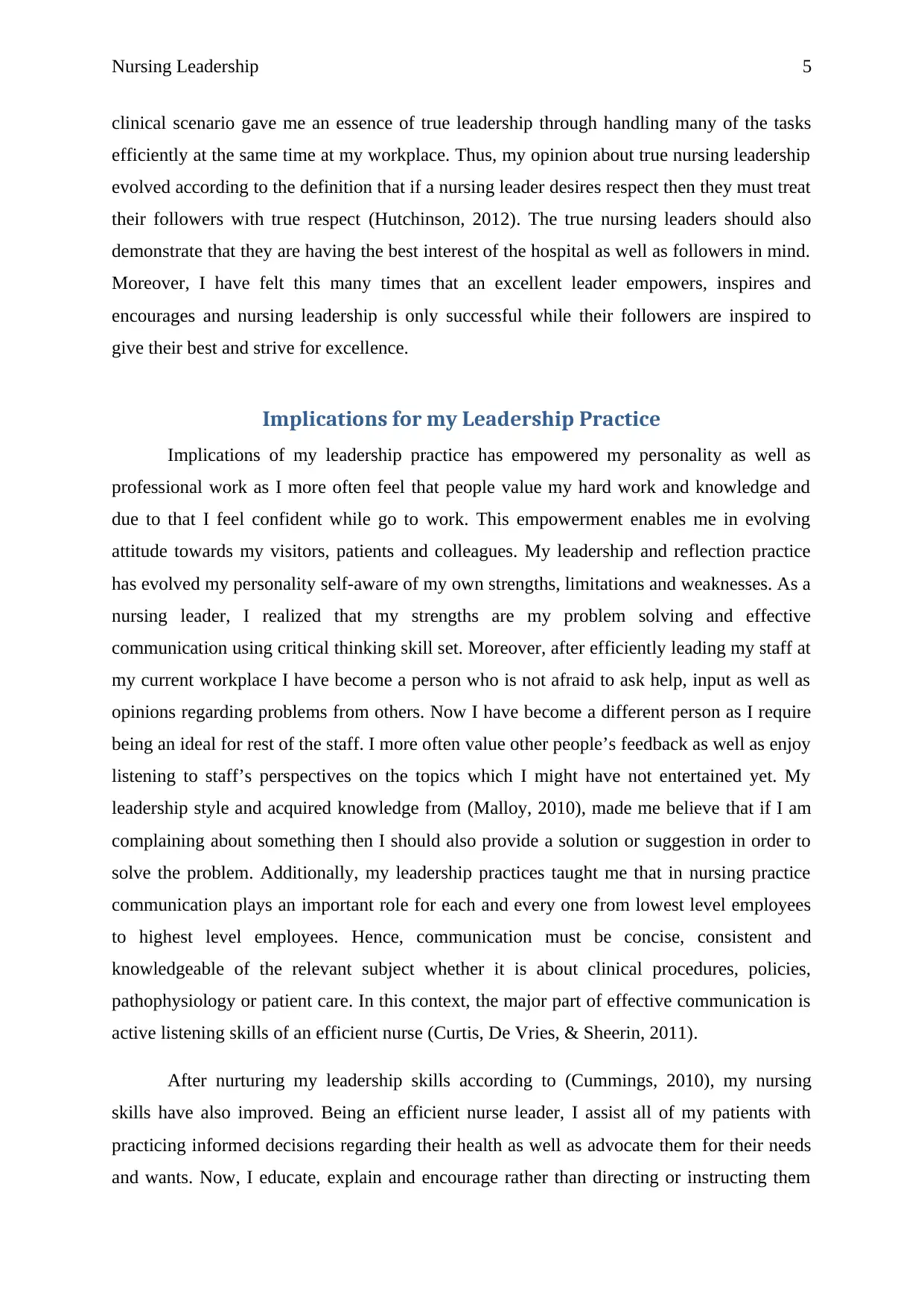
Nursing Leadership 5
clinical scenario gave me an essence of true leadership through handling many of the tasks
efficiently at the same time at my workplace. Thus, my opinion about true nursing leadership
evolved according to the definition that if a nursing leader desires respect then they must treat
their followers with true respect (Hutchinson, 2012). The true nursing leaders should also
demonstrate that they are having the best interest of the hospital as well as followers in mind.
Moreover, I have felt this many times that an excellent leader empowers, inspires and
encourages and nursing leadership is only successful while their followers are inspired to
give their best and strive for excellence.
Implications for my Leadership Practice
Implications of my leadership practice has empowered my personality as well as
professional work as I more often feel that people value my hard work and knowledge and
due to that I feel confident while go to work. This empowerment enables me in evolving
attitude towards my visitors, patients and colleagues. My leadership and reflection practice
has evolved my personality self-aware of my own strengths, limitations and weaknesses. As a
nursing leader, I realized that my strengths are my problem solving and effective
communication using critical thinking skill set. Moreover, after efficiently leading my staff at
my current workplace I have become a person who is not afraid to ask help, input as well as
opinions regarding problems from others. Now I have become a different person as I require
being an ideal for rest of the staff. I more often value other people’s feedback as well as enjoy
listening to staff’s perspectives on the topics which I might have not entertained yet. My
leadership style and acquired knowledge from (Malloy, 2010), made me believe that if I am
complaining about something then I should also provide a solution or suggestion in order to
solve the problem. Additionally, my leadership practices taught me that in nursing practice
communication plays an important role for each and every one from lowest level employees
to highest level employees. Hence, communication must be concise, consistent and
knowledgeable of the relevant subject whether it is about clinical procedures, policies,
pathophysiology or patient care. In this context, the major part of effective communication is
active listening skills of an efficient nurse (Curtis, De Vries, & Sheerin, 2011).
After nurturing my leadership skills according to (Cummings, 2010), my nursing
skills have also improved. Being an efficient nurse leader, I assist all of my patients with
practicing informed decisions regarding their health as well as advocate them for their needs
and wants. Now, I educate, explain and encourage rather than directing or instructing them
clinical scenario gave me an essence of true leadership through handling many of the tasks
efficiently at the same time at my workplace. Thus, my opinion about true nursing leadership
evolved according to the definition that if a nursing leader desires respect then they must treat
their followers with true respect (Hutchinson, 2012). The true nursing leaders should also
demonstrate that they are having the best interest of the hospital as well as followers in mind.
Moreover, I have felt this many times that an excellent leader empowers, inspires and
encourages and nursing leadership is only successful while their followers are inspired to
give their best and strive for excellence.
Implications for my Leadership Practice
Implications of my leadership practice has empowered my personality as well as
professional work as I more often feel that people value my hard work and knowledge and
due to that I feel confident while go to work. This empowerment enables me in evolving
attitude towards my visitors, patients and colleagues. My leadership and reflection practice
has evolved my personality self-aware of my own strengths, limitations and weaknesses. As a
nursing leader, I realized that my strengths are my problem solving and effective
communication using critical thinking skill set. Moreover, after efficiently leading my staff at
my current workplace I have become a person who is not afraid to ask help, input as well as
opinions regarding problems from others. Now I have become a different person as I require
being an ideal for rest of the staff. I more often value other people’s feedback as well as enjoy
listening to staff’s perspectives on the topics which I might have not entertained yet. My
leadership style and acquired knowledge from (Malloy, 2010), made me believe that if I am
complaining about something then I should also provide a solution or suggestion in order to
solve the problem. Additionally, my leadership practices taught me that in nursing practice
communication plays an important role for each and every one from lowest level employees
to highest level employees. Hence, communication must be concise, consistent and
knowledgeable of the relevant subject whether it is about clinical procedures, policies,
pathophysiology or patient care. In this context, the major part of effective communication is
active listening skills of an efficient nurse (Curtis, De Vries, & Sheerin, 2011).
After nurturing my leadership skills according to (Cummings, 2010), my nursing
skills have also improved. Being an efficient nurse leader, I assist all of my patients with
practicing informed decisions regarding their health as well as advocate them for their needs
and wants. Now, I educate, explain and encourage rather than directing or instructing them
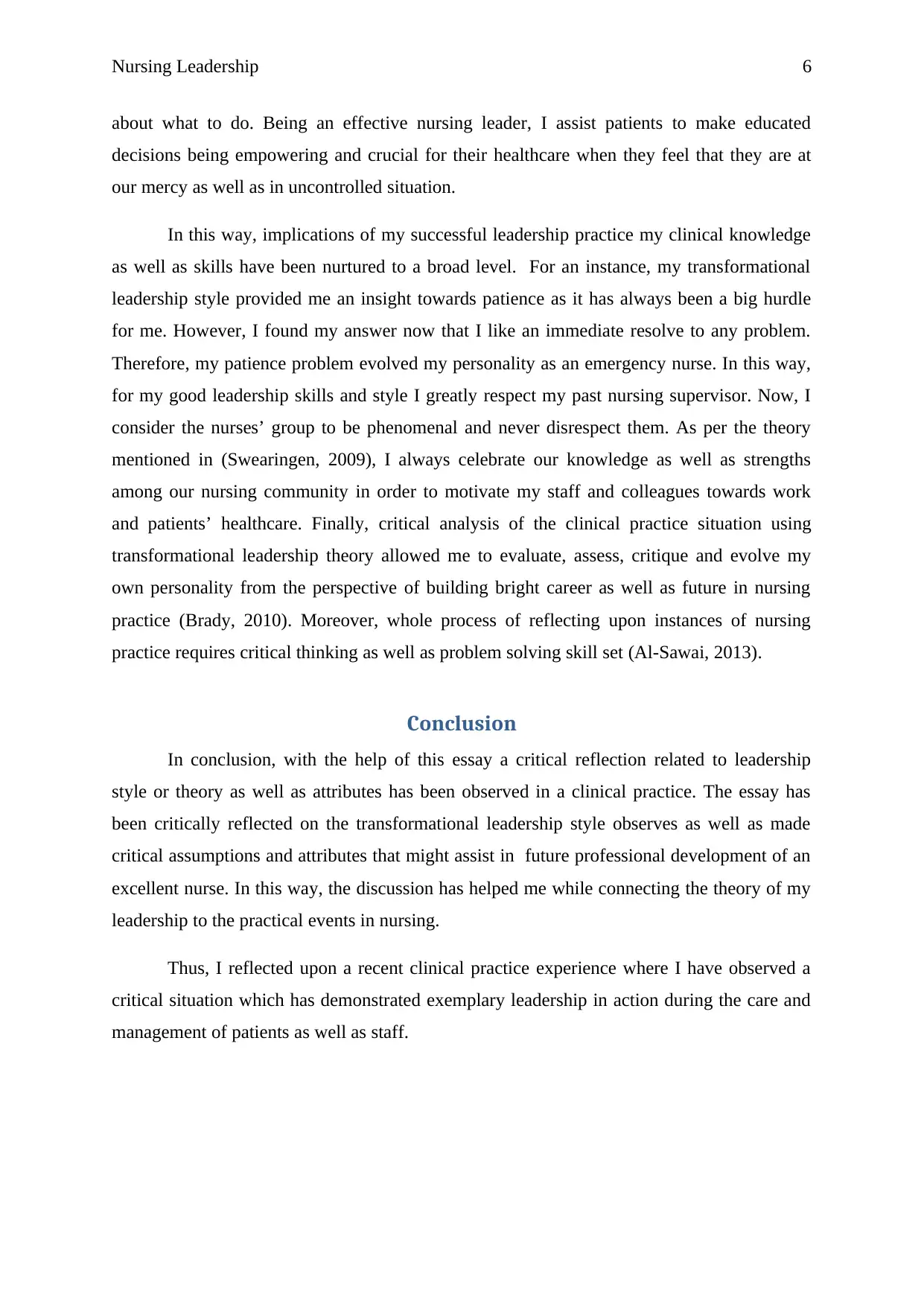
Nursing Leadership 6
about what to do. Being an effective nursing leader, I assist patients to make educated
decisions being empowering and crucial for their healthcare when they feel that they are at
our mercy as well as in uncontrolled situation.
In this way, implications of my successful leadership practice my clinical knowledge
as well as skills have been nurtured to a broad level. For an instance, my transformational
leadership style provided me an insight towards patience as it has always been a big hurdle
for me. However, I found my answer now that I like an immediate resolve to any problem.
Therefore, my patience problem evolved my personality as an emergency nurse. In this way,
for my good leadership skills and style I greatly respect my past nursing supervisor. Now, I
consider the nurses’ group to be phenomenal and never disrespect them. As per the theory
mentioned in (Swearingen, 2009), I always celebrate our knowledge as well as strengths
among our nursing community in order to motivate my staff and colleagues towards work
and patients’ healthcare. Finally, critical analysis of the clinical practice situation using
transformational leadership theory allowed me to evaluate, assess, critique and evolve my
own personality from the perspective of building bright career as well as future in nursing
practice (Brady, 2010). Moreover, whole process of reflecting upon instances of nursing
practice requires critical thinking as well as problem solving skill set (Al-Sawai, 2013).
Conclusion
In conclusion, with the help of this essay a critical reflection related to leadership
style or theory as well as attributes has been observed in a clinical practice. The essay has
been critically reflected on the transformational leadership style observes as well as made
critical assumptions and attributes that might assist in future professional development of an
excellent nurse. In this way, the discussion has helped me while connecting the theory of my
leadership to the practical events in nursing.
Thus, I reflected upon a recent clinical practice experience where I have observed a
critical situation which has demonstrated exemplary leadership in action during the care and
management of patients as well as staff.
about what to do. Being an effective nursing leader, I assist patients to make educated
decisions being empowering and crucial for their healthcare when they feel that they are at
our mercy as well as in uncontrolled situation.
In this way, implications of my successful leadership practice my clinical knowledge
as well as skills have been nurtured to a broad level. For an instance, my transformational
leadership style provided me an insight towards patience as it has always been a big hurdle
for me. However, I found my answer now that I like an immediate resolve to any problem.
Therefore, my patience problem evolved my personality as an emergency nurse. In this way,
for my good leadership skills and style I greatly respect my past nursing supervisor. Now, I
consider the nurses’ group to be phenomenal and never disrespect them. As per the theory
mentioned in (Swearingen, 2009), I always celebrate our knowledge as well as strengths
among our nursing community in order to motivate my staff and colleagues towards work
and patients’ healthcare. Finally, critical analysis of the clinical practice situation using
transformational leadership theory allowed me to evaluate, assess, critique and evolve my
own personality from the perspective of building bright career as well as future in nursing
practice (Brady, 2010). Moreover, whole process of reflecting upon instances of nursing
practice requires critical thinking as well as problem solving skill set (Al-Sawai, 2013).
Conclusion
In conclusion, with the help of this essay a critical reflection related to leadership
style or theory as well as attributes has been observed in a clinical practice. The essay has
been critically reflected on the transformational leadership style observes as well as made
critical assumptions and attributes that might assist in future professional development of an
excellent nurse. In this way, the discussion has helped me while connecting the theory of my
leadership to the practical events in nursing.
Thus, I reflected upon a recent clinical practice experience where I have observed a
critical situation which has demonstrated exemplary leadership in action during the care and
management of patients as well as staff.
Paraphrase This Document
Need a fresh take? Get an instant paraphrase of this document with our AI Paraphraser
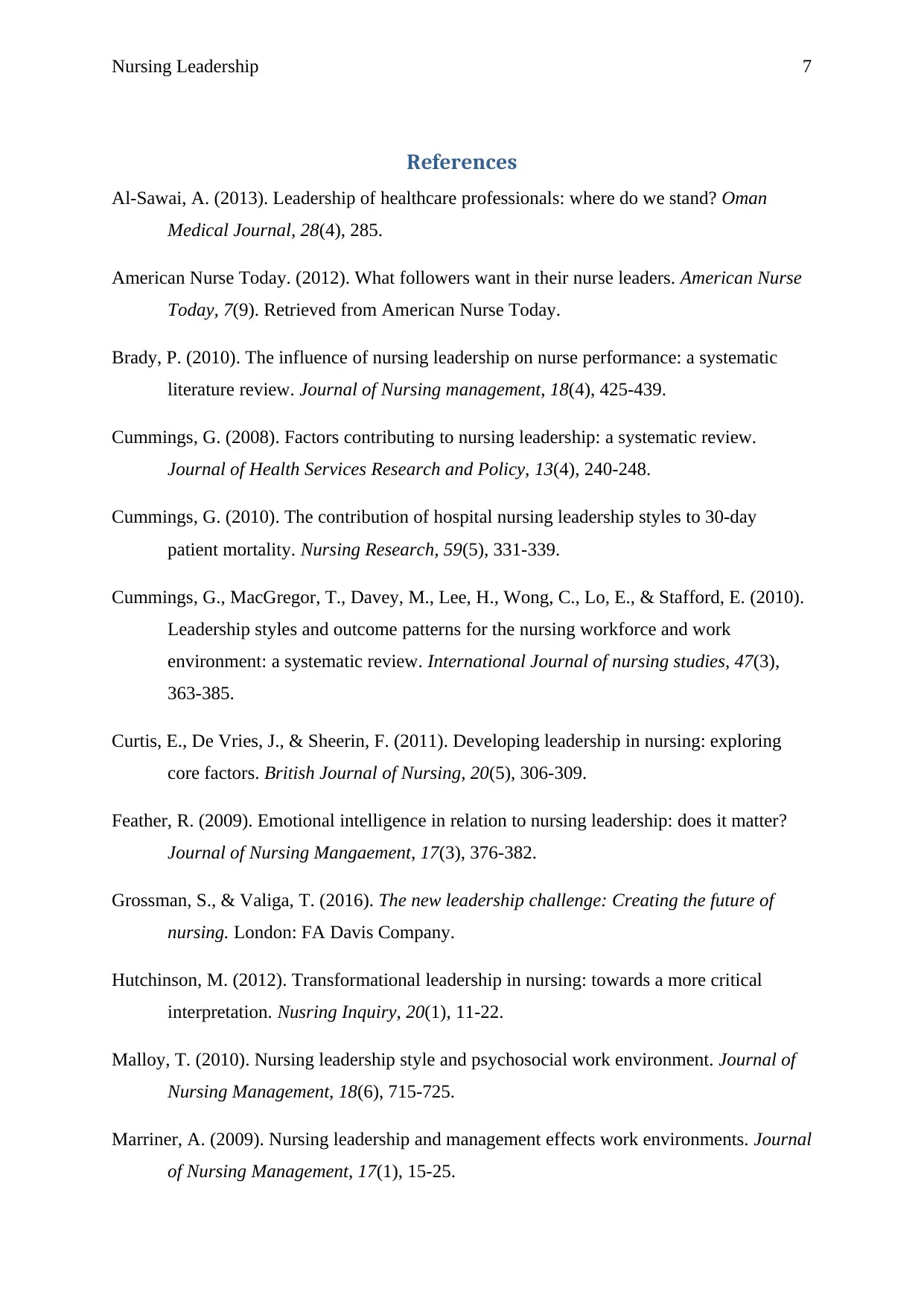
Nursing Leadership 7
References
Al-Sawai, A. (2013). Leadership of healthcare professionals: where do we stand? Oman
Medical Journal, 28(4), 285.
American Nurse Today. (2012). What followers want in their nurse leaders. American Nurse
Today, 7(9). Retrieved from American Nurse Today.
Brady, P. (2010). The influence of nursing leadership on nurse performance: a systematic
literature review. Journal of Nursing management, 18(4), 425-439.
Cummings, G. (2008). Factors contributing to nursing leadership: a systematic review.
Journal of Health Services Research and Policy, 13(4), 240-248.
Cummings, G. (2010). The contribution of hospital nursing leadership styles to 30-day
patient mortality. Nursing Research, 59(5), 331-339.
Cummings, G., MacGregor, T., Davey, M., Lee, H., Wong, C., Lo, E., & Stafford, E. (2010).
Leadership styles and outcome patterns for the nursing workforce and work
environment: a systematic review. International Journal of nursing studies, 47(3),
363-385.
Curtis, E., De Vries, J., & Sheerin, F. (2011). Developing leadership in nursing: exploring
core factors. British Journal of Nursing, 20(5), 306-309.
Feather, R. (2009). Emotional intelligence in relation to nursing leadership: does it matter?
Journal of Nursing Mangaement, 17(3), 376-382.
Grossman, S., & Valiga, T. (2016). The new leadership challenge: Creating the future of
nursing. London: FA Davis Company.
Hutchinson, M. (2012). Transformational leadership in nursing: towards a more critical
interpretation. Nusring Inquiry, 20(1), 11-22.
Malloy, T. (2010). Nursing leadership style and psychosocial work environment. Journal of
Nursing Management, 18(6), 715-725.
Marriner, A. (2009). Nursing leadership and management effects work environments. Journal
of Nursing Management, 17(1), 15-25.
References
Al-Sawai, A. (2013). Leadership of healthcare professionals: where do we stand? Oman
Medical Journal, 28(4), 285.
American Nurse Today. (2012). What followers want in their nurse leaders. American Nurse
Today, 7(9). Retrieved from American Nurse Today.
Brady, P. (2010). The influence of nursing leadership on nurse performance: a systematic
literature review. Journal of Nursing management, 18(4), 425-439.
Cummings, G. (2008). Factors contributing to nursing leadership: a systematic review.
Journal of Health Services Research and Policy, 13(4), 240-248.
Cummings, G. (2010). The contribution of hospital nursing leadership styles to 30-day
patient mortality. Nursing Research, 59(5), 331-339.
Cummings, G., MacGregor, T., Davey, M., Lee, H., Wong, C., Lo, E., & Stafford, E. (2010).
Leadership styles and outcome patterns for the nursing workforce and work
environment: a systematic review. International Journal of nursing studies, 47(3),
363-385.
Curtis, E., De Vries, J., & Sheerin, F. (2011). Developing leadership in nursing: exploring
core factors. British Journal of Nursing, 20(5), 306-309.
Feather, R. (2009). Emotional intelligence in relation to nursing leadership: does it matter?
Journal of Nursing Mangaement, 17(3), 376-382.
Grossman, S., & Valiga, T. (2016). The new leadership challenge: Creating the future of
nursing. London: FA Davis Company.
Hutchinson, M. (2012). Transformational leadership in nursing: towards a more critical
interpretation. Nusring Inquiry, 20(1), 11-22.
Malloy, T. (2010). Nursing leadership style and psychosocial work environment. Journal of
Nursing Management, 18(6), 715-725.
Marriner, A. (2009). Nursing leadership and management effects work environments. Journal
of Nursing Management, 17(1), 15-25.
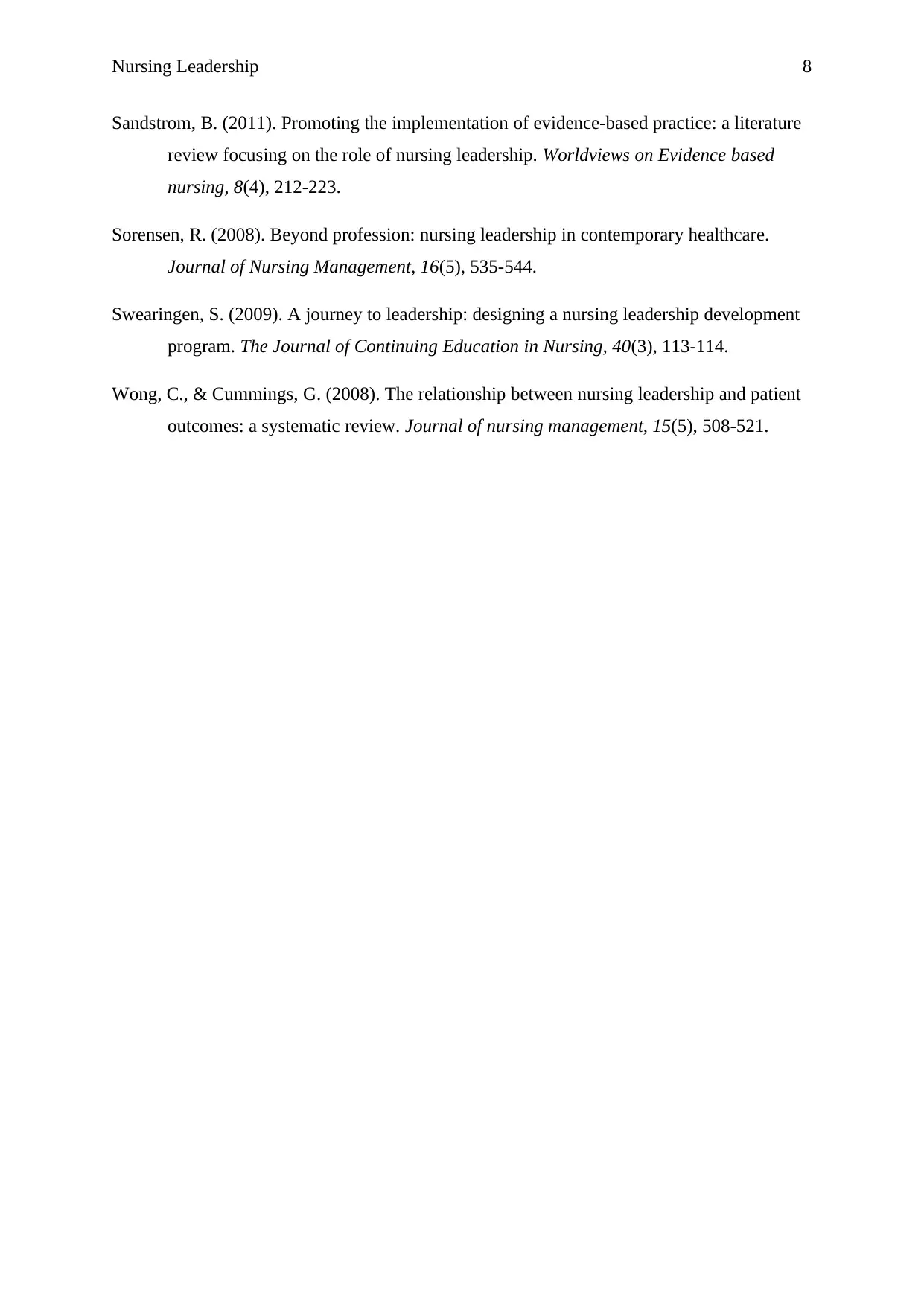
Nursing Leadership 8
Sandstrom, B. (2011). Promoting the implementation of evidence-based practice: a literature
review focusing on the role of nursing leadership. Worldviews on Evidence based
nursing, 8(4), 212-223.
Sorensen, R. (2008). Beyond profession: nursing leadership in contemporary healthcare.
Journal of Nursing Management, 16(5), 535-544.
Swearingen, S. (2009). A journey to leadership: designing a nursing leadership development
program. The Journal of Continuing Education in Nursing, 40(3), 113-114.
Wong, C., & Cummings, G. (2008). The relationship between nursing leadership and patient
outcomes: a systematic review. Journal of nursing management, 15(5), 508-521.
Sandstrom, B. (2011). Promoting the implementation of evidence-based practice: a literature
review focusing on the role of nursing leadership. Worldviews on Evidence based
nursing, 8(4), 212-223.
Sorensen, R. (2008). Beyond profession: nursing leadership in contemporary healthcare.
Journal of Nursing Management, 16(5), 535-544.
Swearingen, S. (2009). A journey to leadership: designing a nursing leadership development
program. The Journal of Continuing Education in Nursing, 40(3), 113-114.
Wong, C., & Cummings, G. (2008). The relationship between nursing leadership and patient
outcomes: a systematic review. Journal of nursing management, 15(5), 508-521.
1 out of 9
Related Documents
Your All-in-One AI-Powered Toolkit for Academic Success.
+13062052269
info@desklib.com
Available 24*7 on WhatsApp / Email
![[object Object]](/_next/static/media/star-bottom.7253800d.svg)
Unlock your academic potential
© 2024 | Zucol Services PVT LTD | All rights reserved.





